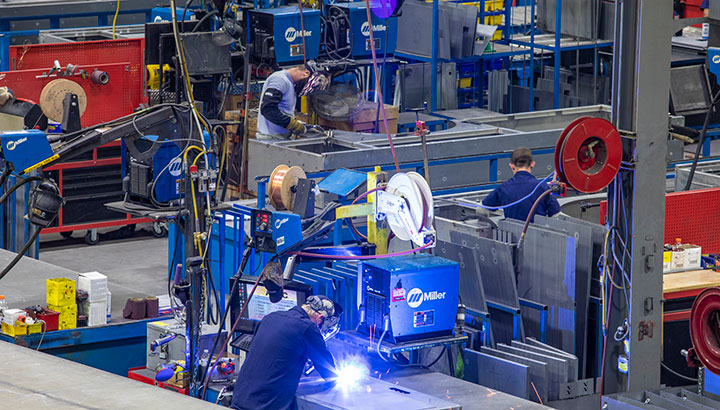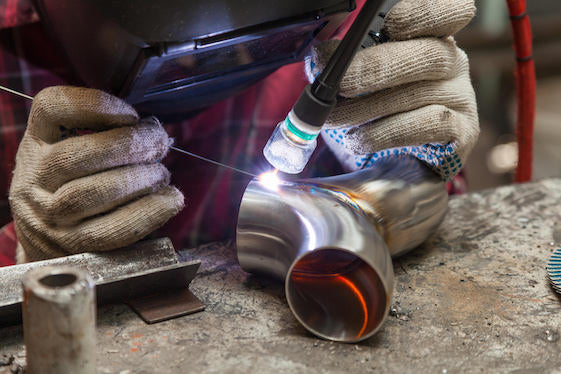All Concerning Welding: Trick Insights Into Techniques and Ideal Practices for Success
Welding encompasses a variety of techniques, each fit for details products and applications. Understanding these methods, such as GMAW, SMAW, and TIG, is necessary for attaining ideal results. Moreover, the right tools and safety and security practices can not be neglected. As prep work and repairing play crucial functions in the welding process, mastering these aspects can greatly enhance the quality of the last item. What are the crucial elements that ensure an effective weld?
Understanding Various Welding Strategies
Welding strategies include a range of approaches, each matched to details applications and products. Amongst the most common strategies are Gas Steel Arc Welding (GMAW), Protected Metal Arc Welding (SMAW), and Tungsten Inert Gas Welding (TIG) GMAW, also referred to as MIG welding, is popular for its rate and adaptability, making it excellent for slim products. SMAW, or stick welding, is favored for its simpleness and efficiency in outdoor environments, particularly with thicker steels. TIG welding uses accuracy and control, making it suitable for elaborate job and non-ferrous metals (Belgrade Welding). Each method has its one-of-a-kind benefits and considerations, allowing welders to select the most effective technique based upon the task's requirements, material kind, and desired results. Understanding these methods is necessary for effective welding
Important Welding Devices and Devices
While different welding strategies require details skills, the ideal tools and devices are similarly crucial for accomplishing quality outcomes. Important welding tools includes welding makers, which differ depending on the method-- such as MIG, TIG, or stick welding. Safety gear, including aprons, handwear covers, and headgears, guarantees safety and convenience throughout the process. In addition, fixtures and clamps help secure materials in position, guaranteeing accuracy in welds. Consumables like welding rods, wire, and shielding gas are additionally vital parts that affect the high quality of the weld. Tools such as grinders and cutters assist in surface preparation and post-weld completing, contributing to an expert result. Buying top quality devices ultimately boosts the efficiency and performance of welding projects.
Safety And Security Practices in Welding
Proper security practices are necessary in the welding market to safeguard workers from potential risks. Welders have to put on appropriate personal safety tools (PPE), consisting of headgears with proper shading, gloves, and flame-resistant clothing. Ample air flow is crucial to minimize exposure to harmful fumes and gases created throughout the welding process. Additionally, employees should be learnt the appropriate handling of welding equipment to avoid mishaps. Fire security actions, such as keeping combustible products far from the welding area and having fire extinguishers readily available, are needed. Regular examinations of devices and work areas can aid determine possible risks prior to they result in accidents. By adhering to these safety methods, welders can create a more secure working setting and decrease risks related to their profession.
Preparing Materials for Welding
Preparing products for welding is a vital action that greatly influences the quality and stability of the end product (Montana Mobile Welding and Repair). Proper preparation involves cleaning the surface areas to remove impurities such as rust, dust, and oil, which can jeopardize the weld. Techniques such as grinding, sanding, or utilizing solvents are frequently used to attain a clean surface area. Additionally, making sure that the products mesh snugly is essential; gaps can bring about weak welds. It's also important to take into account the alignment and positioning of the parts, as this will certainly impact the convenience of welding and the final result. Finally, choosing the ideal filler product and ensuring compatibility with the base metals is vital for accomplishing solid, sturdy welds
Tips for Achieving High-Quality Welds
Achieving top notch welds requires interest to detail and adherence to best practices throughout the welding process. Correct joint prep work is necessary, making sure surface areas are tidy and cost-free from pollutants. Picking the suitable filler product and welding technique based upon the base metals is essential for excellent bonding. Maintaining regular travel rate and angle while welding can advertise and prevent problems uniformity. In addition, controlling heat input is essential; extreme heat can cause bending and weakened joints. If required, frequently evaluating the welds throughout the procedure allows for prompt changes. Finally, utilizing appropriate post-weld therapies, such as cleaning and stress alleviation, can boost the longevity and honesty of the weld, inevitably making sure a successful outcome.
Troubleshooting Typical Welding Issues
Welding usually provides difficulties that can impact the high quality and integrity of the final item. Usual concerns such as porosity, inconsistent weld beads, and overheating can develop, each calling for specific fixing strategies. Understanding additional resources these troubles is important for welders to boost their abilities and achieve suitable outcomes.
Porosity Issues Explained
Porosity can typically be overlooked, it stays a crucial issue in welding that can compromise the stability of an ended up item. Porosity refers to the visibility of small gas pockets within the weld grain, which can lead and damage the joint to premature failing. This trouble typically develops from impurities, moisture, or incorrect protecting gas coverage during the welding procedure. To mitigate porosity, welders need to verify that the base materials are tidy and dry, use suitable securing gases, and keep regular welding criteria. Consistently examining the devices and environment can additionally assist recognize prospective problems prior to they manifest in the weld. Addressing porosity efficiently is crucial for achieving solid, sturdy welds that meet quality requirements.

Inconsistent Weld Beans
Irregular weld grains can greatly influence the high quality and strength of a completed item. Various elements add to this issue, consisting of improper travel speed, wrong amperage settings, and irregular electrode angles. When the welder moves as well promptly, a bead might show up slim and lack penetration, while relocating also slowly can cause too much accumulation. Additionally, utilizing the incorrect amperage can result in either undercutting or too much spatter, both of which compromise weld honesty. The welder's strategy, such as irregular torch activity, can also result in uneven bead look. To minimize these problems, welders ought to concentrate on keeping consistent, regulated activities and guaranteeing proper devices setups to attain uniformity in their welds. Uniformity is vital to achieving reliable and solid welds.
Getting Too Hot and Warping Issues
Excessive warm during the welding process can bring about significant overheating and contorting issues, affecting the structural stability of the workpiece. These troubles commonly stainless steel welding near me manifest as distortion, which website here can compromise alignment and fit-up, making further assembly testing. Aspects adding to overheating consist of the choice of welding criteria, such as voltage and take a trip speed, as well as the type of product being bonded. To reduce these issues, welders should keep consistent travel rate and appropriate heat input while keeping an eye on the workpiece temperature level. Furthermore, preheating or post-weld warmth therapy can assist ease anxieties brought on by fast air conditioning - Belgrade. Normal assessment and adherence to finest techniques are vital in preventing overheating and ensuring the long life and dependability of welded frameworks
Frequently Asked Questions
What Are the Profession Opportunities in the Welding Industry?
The welding market provides varied career possibilities, including placements as welders, educators, engineers, and assessors. Professionals can function in manufacturing, building and construction, aerospace, and automobile sectors, profiting from strong need and affordable wages in various functions.
How Can I Boost My Welding Speed Without Giving Up Quality?
To boost welding speed without sacrificing high quality, one need to practice reliable methods, keep equipment, maximize setups, and enhance hand-eye sychronisation. Regular training and seeking feedback can additionally greatly add to accomplishing quicker, top quality welds.
What Certifications Are Readily Available for Welders?
Many certifications exist for welders, consisting of those from the American Welding Culture (AWS), the National Facility for Construction Education And Learning and Research (NCCER), and different industry-specific companies. These credentials enhance employability and show ability proficiency.
Exactly How Does Welding Impact the Features of Metals?
Welding influences the residential or commercial properties of metals by altering their microstructure, which can lead to adjustments in hardness, toughness, and ductility. Warmth input and air conditioning prices during the procedure considerably affect these product characteristics.
Can I Bonded Dissimilar Metals With Each Other?

Comments on “Correcting cracking in welded joints: tips from Montana Mobile Welding and Repair Fabrication”